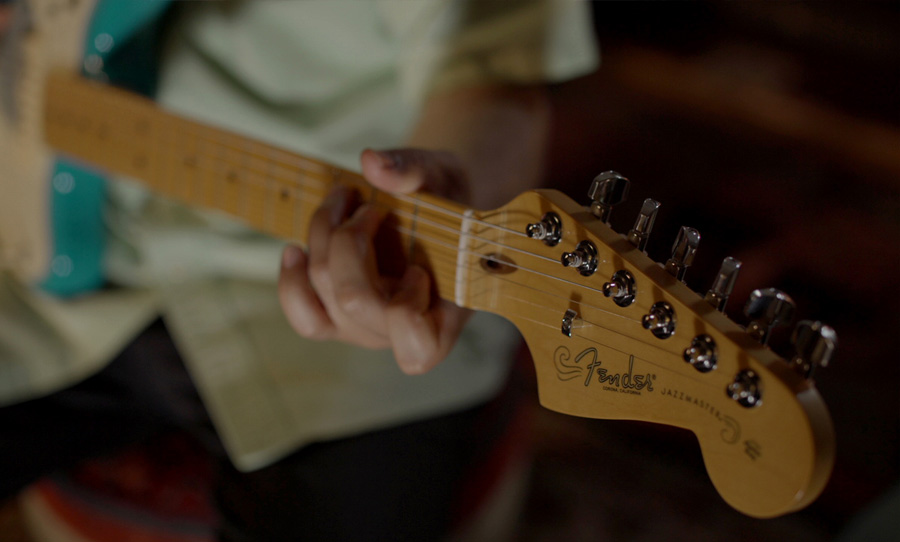Since the late ’50s, the Fender Jazzmaster has found itself in the hands of rockers who like to do things differently. At Engineering the Sound, we wanted to see this beauty in action.
After the success of the Stratocaster and the Telecaster — which are perched somewhere close to the top of the electric guitar family tree — Fender saw fit to experiment relatively early on in their history. The Jazzmaster (introduced in 1958) was supposed to be Fender’s entrée into the world of — you guessed it — jazz.
Though it didn’t make significant inroads into this sphere, it did something even better (especially for Fender’s bottom line): it penetrated the rock ‘n’ roll scene, especially in the burgeoning sub-genre of surf. Throughout the subsequent decades, the Jazzmaster cemented its status as an off-kilter rock emblem, gluing itself to punks like Elvis Costello, shoegazers like Kevin Shields and grunge virtuosos like J Mascis.
The latest addition to this storied line of guitars, the American Professional II embodies the finest Jazzmaster traditions. It’s boldly unconventional, dreamy to play, and boasts a sound that can’t help but satisfy. It was easy for the crew of Engineering the Sound to fall under its spell.
The American Professional II Jazzmaster didn’t get that name for nuthin’. Its case (a Deluxe Moulded Case, no less) is a top-quality affair. As any guitarist that has done a few gigs will tell you, some cases have a disappointingly short lifespan. It’s clear that this case, which snaps shut reassuringly tightly and opens smoothly, is built to last. It might seem like a minor detail but just like someone who dresses sharply for a job interview, you can tell it means business.
Upon opening the case, the view is gorgeous. For many, offsets represent the pinnacle of Fender design. Replete with mid-century aesthetic charm, ergonomic design, and just enough quirkiness, you’re instantly reminded that you’re laying eyes on a classic.
The Deep C neck feels comfortable and accessible in all registers, especially beyond the twelfth fret. Playing fully-voiced chords in this register can sometimes be difficult, but the neck shape, natural finish and sculpted neck heel makes this style of playing intuitive.

One of the key assets of the original Jazzmaster was the inclusion of a revolutionary tremolo system — one of the essential components of the surf rock sound. The new Panorama tremolo system pays tribute to this Jazzmaster archetype while enhancing it. The width of pitch-bending capability here is astonishing. The only problem is that it’s too easy to become addicted woozily bending every note!
And of course, being a Jazzmaster of the finest pedigree, it comes with the cleverly designed rhythm circuit. To understand how this works, it’s best to focus on the small, vertical switch above the neck of the guitar. When this switch is in the down position, the pickups are wired in parallel and volume and tone can be tweaked with the conventional rotary pots.
Flick that little switch up and the volume and tone can be adjusted by the small wheels above the pickups.

In the up position, the Rhythm circuit is engaged, perfect for giving voice to full-blooded open chords. In the down or ‘Lead’ position, the Jazzmaster takes on a decidedly chimey character, perfect for piercing solos or ethereal upper-register arpeggios.
Beyond that, you also select between neck and bridge pickups, or engage both simultaneously via the pickup switch, located below the bottom cutaway. Speaking of the pickups, the guitar ships with Fender’s V-Mod II single-coil soapbars, which provide superb balance in tone and effortless articulation.
Watch as a Luke Saunders from Eagle Eye Jones puts the American Professional II through its paces. Delivering a specially arranged performance of an as-yet-unreleased track, 3021, the guitarist coaxes a fully-realised soundscape from the Jazzmaster, using its unadulterated, clean brilliance as its bedrock.
With the American Professional II, Fender has proven that there are new ways to interpret a sixty-year-old tradition. Adhering to what’s made the Jazzmaster an icon and enhancing its features at the same time is no mean feat, but this guitar makes it look easy.
Find out more about the American Professional II series here.



